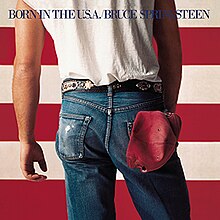In 1984 Bruce Springsteen released "Born in the U.S.A" which would go on to become one of the best selling albums not only of the 80s but of all time as well, selling well over 30 million copies world wide, and upwards of 15 million albums in the U.S. alone. The album also produced a string of 7 Top 10 singles, which ties the record with Michael Jackson's "Thriller" and Janet Jackson's "Rhythm Nation 1814," with the lead single being Dancing in the Dark. The accompanying music video for the song (see above) was the first music video in which The Boss actually appeared, since the 1982 video for Atlantic City didn't actually feature Springsteen, it was in a non-representational form, just showing stark blank and white images of Atlantic City. The massive sales of "Born in the U.S.A" as well as other albums from the 1980's demonstrate the rampant consumerism that was beginning to come into existence, from Nike shoes to CD's people were eager to consume more and more.
The music video features The Boss and the E Street Band simply performing the song on a stage during a concert, making his showmanship and stage presence the focus of the video. While the Thriller music video had been released a year early, demonstrating just how far the medium could be taken, the simplicity of the Dancing in the Dark video seems to be another form of experimenting, figuring out how best to sell a less theatrical non-nonsense musician to a wide mainstream audience. The music video flaunts Springsteen's new ripped physique, in the lead up to the albums release he'd been through a rigorous fitness regime in order to reinvent himself as a masculine and sexualised rock star, an image which would be easier to sell to the general public in an increasingly commercialised 1980's America. Tight blue jeans were used to highlight this new image, with The Boss wearing them in the Dancing in the Dark music video and more famously on the cover of "Born in the U.S.A."
However the realist lyrical themes of the album as a whole, and Dancing in the Dark specifically, dealing with the hardships and harshness of every day life, particularly for working class America, seen in lyrics such as "Man I ain't getting nowhere, I'm just living in a dump like this," clash with the success and prosperity of the era as portrayed by the Reagan administration in "Morning in America." In a 1984 interview with Rolling Stone magazine Bruce Springsteen stated "well, it's not morning in Pittsburgh," as the city was going through a process of industrialization, making thousands of people unemployed.
Hoodie Allen (stage name of Steven Markowitz) is an American hip-hop artist from New York City. Hailing from a middle class upbringing on Long Island, his music, like other White Boy Rappers such as Sammy Adams, Asher Roth, Mac Miller, and Timeflies, fuses rapping with pop sensibilities, electronic music and lyrics not about life on the streets and gang culture, but about college, partying, broken hearts and references to pop culture, all influenced by their middle class backgrounds. A legacy of the birth of rap music during the 1980s, with the white kids who grew up listening to Public Enemy, Beastie Boys and Run DMC wanting to emulate them.
http://www.hoodieallen.com/
Now I'm guessing most of you haven't heard of Hoodie Allen before, until I went on the American Exchange I'd never heard of him either, he is however pretty popular in America, his music videos do have millions of views on YouTube, and his 2012 EP "All American" reached number 10 in the US charts, as well as number 1 on iTunes chart. While he isn't a massively successful artist, the reason I picked him as a representation of contemporary culture is because he's a very modern artist; he isn't signed to a label and self-releases all his music, you can download all his albums and mixtapes from his website for free (see above) and uses his fans to promote his shows in their cities, with Hoodie Mob offering rewards for fans who put up posters, hand out flyers, invite people to the event on Facebook. As a totally self-reliant artist he is the example of how the music industry is being evolved and revolutionised by the internet, partly out of necessity because of illegal downloads, and when people in thirty years look back trying to find why the music industry is the way it is, Hoodie Allen's success will surely be a turning point, perhaps paving the way for a world where without records labels.
The hyper-sexualised nature of the Cake Boy music video, with the two women in the video wearing very short shorts and dancing provocatively, seems to be done with a tongue in cheek tone like its parodying a culture where sex is used to sell everything, even baked goods.
Finally when people in thirty years look back on our culture the evolution of lyric videos, which are used to promote a single in the lead up to the release of the music video and often times weeks before it becomes available to buy as an extra way to hype up a song, as evidence of a culture addicted to consumption and companies finding more and more ways to sell their products to the mass public. The glossy high quality nature of these lyric videos, which have almost become music videos themselves these days, are designed to be eye catching and attention grabbing just like music video are supposed to be, but instead of being produced for circulation on MTV they are purpose built for the internet, often being used as adverts before other videos on YouTube.

No comments:
Post a Comment